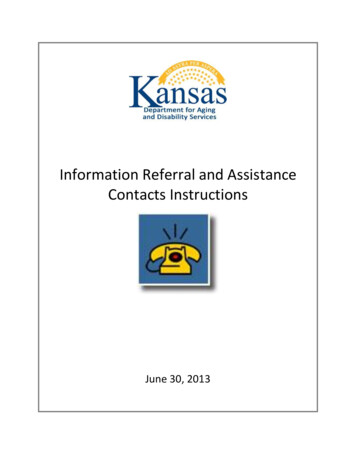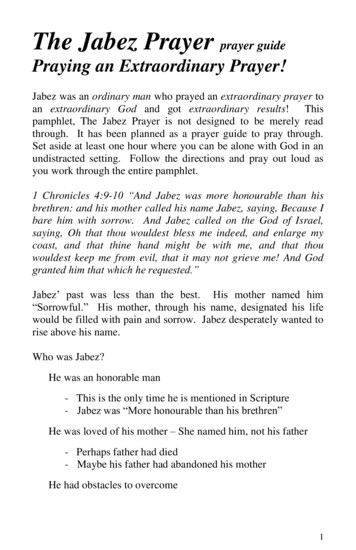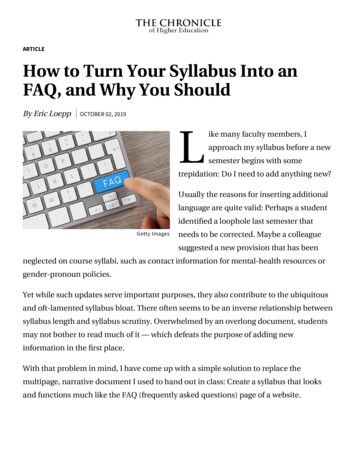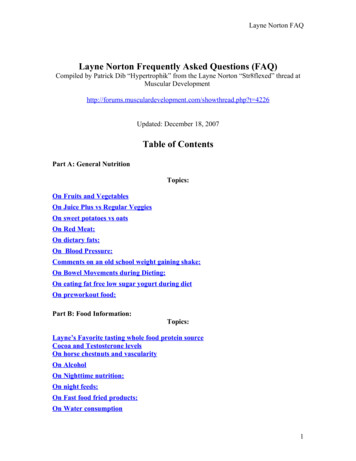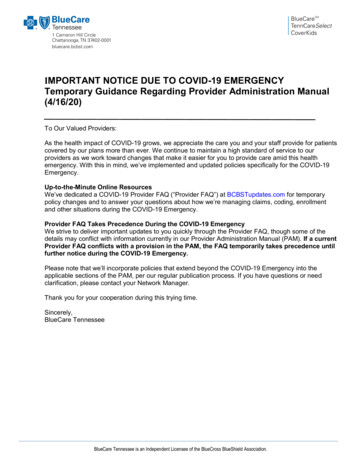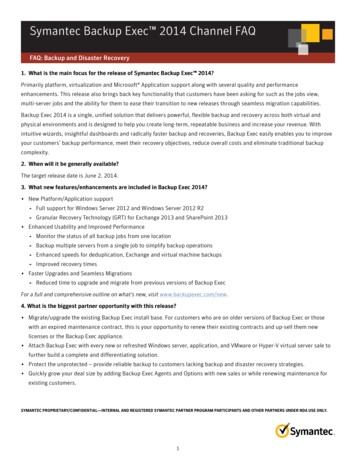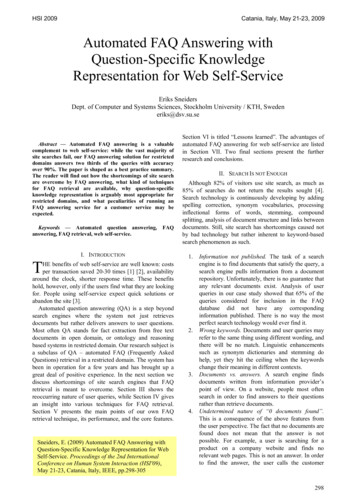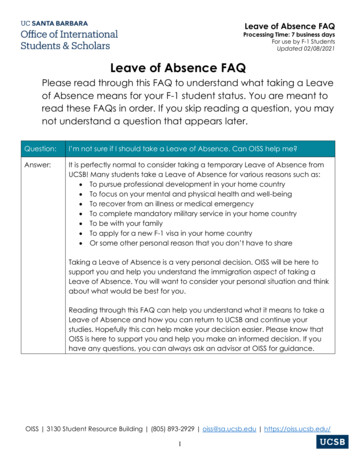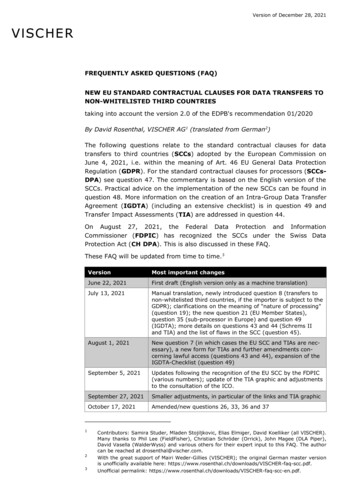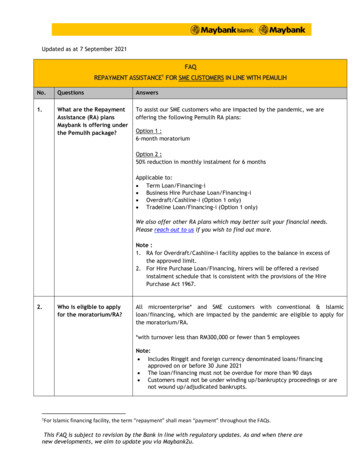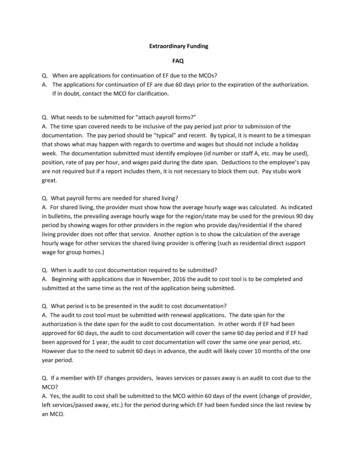
Transcription
Extraordinary FundingFAQQ. When are applications for continuation of EF due to the MCOs?A. The applications for continuation of EF are due 60 days prior to the expiration of the authorization.If in doubt, contact the MCO for clarification.Q. What needs to be submitted for “attach payroll forms?”A. The time span covered needs to be inclusive of the pay period just prior to submission of thedocumentation. The pay period should be “typical” and recent. By typical, it is meant to be a timespanthat shows what may happen with regards to overtime and wages but should not include a holidayweek. The documentation submitted must identify employee (id number or staff A, etc. may be used),position, rate of pay per hour, and wages paid during the date span. Deductions to the employee’s payare not required but if a report includes them, it is not necessary to block them out. Pay stubs workgreat.Q. What payroll forms are needed for shared living?A. For shared living, the provider must show how the average hourly wage was calculated. As indicatedin bulletins, the prevailing average hourly wage for the region/state may be used for the previous 90 dayperiod by showing wages for other providers in the region who provide day/residential if the sharedliving provider does not offer that service. Another option is to show the calculation of the averagehourly wage for other services the shared living provider is offering (such as residential direct supportwage for group homes.)Q. When is audit to cost documentation required to be submitted?A. Beginning with applications due in November, 2016 the audit to cost tool is to be completed andsubmitted at the same time as the rest of the application being submitted.Q. What period is to be presented in the audit to cost documentation?A. The audit to cost tool must be submitted with renewal applications. The date span for theauthorization is the date span for the audit to cost documentation. In other words if EF had beenapproved for 60 days, the audit to cost documentation will cover the same 60 day period and if EF hadbeen approved for 1 year, the audit to cost documentation will cover the same one year period, etc.However due to the need to submit 60 days in advance, the audit will likely cover 10 months of the oneyear period.Q. If a member with EF changes providers, leaves services or passes away is an audit to cost due to theMCO?A. Yes, the audit to cost shall be submitted to the MCO within 60 days of the event (change of provider,left services/passed away, etc.) for the period during which EF had been funded since the last review byan MCO.
Q. What happens if a member changes MCOs with regards to the “audit to cost”?A. Audit to cost documentation shall be submitted to the MCO that approved EF within 60 days of theevent (changed MCOs) for the period the provider received EF for the Member.Q. What is “above the normal cost of doing business” with regards to equipment/supplies?A. “Normal cost of doing business” is that amount that is needed for the average person served.Q. If we have a “lead direct care worker” where do we include this person and their wages in thethreshold calculation?A. Include this person in the direct care staff average hourly wage calculation and hours.Q. Can maintenance staff person or IT staff be included in the calculation of professional staff? Whatabout a consultant that assists our agency in completing the required EF paperwork?A. Typically professional staff are providing a direct service to the individual and it is above what isrequired by the “average” consumer. Consultants who assist the agency with paperwork would be partof the cost of doing business and included in the administrative percentage automatically calculated inthe worksheet.Q. We have a “nursing supervisor,” which is required for supervisor of LPNs and a behavioral supervisorfor the staff in behavioral services, where do we count these supervisory staff in the calculations?A. If the supervisors are not providing a direct service to the individual, they are accounted for in theadministrative percentage and are not listed separately. If there are some direct support functions forexample that only an RN can provide and other functions that can be provided by the LPNs, then bothRN and LPN may be listed under professional staff. Time of the RN is specific to the direct supportfunction and does not include supervisory time.Q. We, as a provider received feedback that a piece of equipment/supplies was not approved but the EFwas approved. How do we account for this in the audit to cost at the end of the approval period?A. Only those components approved by the MCO are to be accounted for in the audit to costdocumentation. If a piece of equipment or service such as Nursing was provided by the provider but notincluded in the EF rate by the MCO, it should not be shown in the audit to cost documentation.Q. How are the six levels of justification for EF used?A. Members must have an extraordinary health and/or behavioral need that presents a threat to themember’s safety to be eligible for extraordinary funding. These 6 levels at looked at by the MCO inevaluating the member’s health/safety needs.Q. What is summarized/interpreted behavioral data?A. The data in question are those that are collected on targets of the Behavior Support Plan. Theregulations (Article 30-63-23) require periodic review to determine the effectiveness of the plan so the
interpretations are the notes of those reviews. Specifically, what actions are being taken in response tothe behavioral data collected instead of continuing a BSP without change when the rates are climbingand the plan is not effective. Or conversely, when a plan has been very effective what steps are beingtaken to modify the plan to reduce the restrictiveness, etc. The documentation will demonstrate thatdata are being collected in accordance with the BSP and that the plan is being regularly reviewed anddata interpreted.Q. Why is the MCO saying “need was not demonstrated?”A. The summary submitted, PSCP, BSP and observations conducted by MCO staff must all demonstratethe individual has an “extraordinary need.”Q. The PCSP is not being updated and doesn’t reflect what the team has indicated to be the need of theindividual especially in documenting the individual’s extraordinary need. What do we do as the providerbecause TCM is independent of the provider?A. Article 30-63-21 outlines the requirements of the PCSP and the responsibility for regular review andupdates. The provider should discuss the matter with the TCM and attempt to work out the issues. Ifthere are unresolved concerns, the provider should discuss the matter with the CDDO, licensing staffand possibly the member’s guardian. The MCO expects to find confirmation of the member’sextraordinary need in the PCSP to match what is being stated in the summary.Q. What is “specialized training”?A. Article 30-63-26 specifies the minimum training required in the course of doing business as aday/residential provider of IDD waiver services. Training above these minimums that are provided tothe staff working with this individual that are not also provided to all staff at the agency and that arerelated to the individual’s extraordinary need. For example, training on how to feed someone viagastrostomy tube is a training provided to all staff at agency X. This then is not specialized trainingprovided to staff working with individual A based upon his needs for this type of feeding due to hisextraordinary medical needs.Q: As a provider, how do we demonstrate that the preventative measures for a member continue to beextraordinary even though the extraordinary behavior may not be occurring as often?A: Within the justification, the provider should describe the preventative staffing needed, the reasonwhy that level of staffing is kept, what attempts have been made to reduce the staffing supports and theoutcome (when they occurred and what happened), any other preventative measures tried. Themember should continue to have a behavior support plan which indicates what preventative measuresthe staff are taking to keep the behavior at a low level. The level of intensity and frequency of thebehavior prior to the preventative measures being put into place should be described as well.Q. What is expected in terms of justification for an initial application of EF?A. The provider must submit a written justification that demonstrates the member meets one of thethree criteria specified in the KDADs policy on EF for submission of an initial application. Thejustification should be submitted separately from the EF application or as a cover sheet to the
application and is really a first step in the process. It should be clear from the information submittedwhy/how the member meets the criteria as stated in the policy. Do not assume the MCO knows themember and the circumstances, the decision must be based upon what the Provider submits. If theMember is in imminent risk of placement in a nursing facility, correctional facility or public or privateICF/IDD, provide evidence of that risk. If the Member is recently transitioning out of a nursing facility,correctional facility or public or private ICF/IDD or a psychiatric residential treatment facility, provide theproposed discharge date or discharge date and evidence of extraordinary need. If the member is thesubject of a confirmed abuse, neglect or exploitation related to the extraordinary behavioral or healthcondition, provide evidence related to this criteria.Q. Where do we find the audit to cost tool?A. It is located on the KDADs website under forms.Q. Where is the training cost on the uniform funding tools?A. The PDF form is under revision to have that added. The Excel tool has included this on the thresholdcalculation worksheet and the provider needs to change the hours to one if there is specialized training.Q. If we choose to use the Excel Uniform funding tool, what else needs to be submitted?A. The Excel version of the uniform funding tool requires submission of the EF summary pages andchecklist (word documents) also found on the KDADs website. All items listed on the checklist are to besubmitted as well as the justification page.Q. If we choose to use the PDF form of the uniform funding tool, what else needs to be submitted?A. All of the items listed on the checklist and the justification page must be submitted along with thePDF form of the uniform funding tool as it includes the cost sheets as well as the summary pages.
Extraordinary Funding FAQ Q. When are applications for continuation of EF due to the MCOs? A. The applications for continuation of EF are due 60 days prior to the expiration of the authorization. If in doubt, contact the MCO for clarification. Q. What needs to be submitted for "attach payroll forms?" A.
